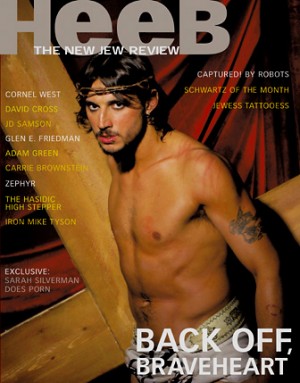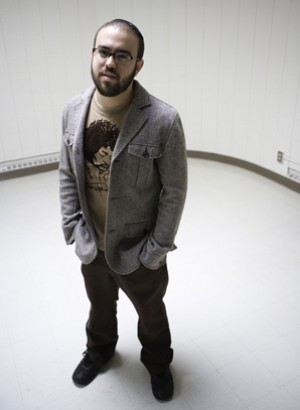Is There a Future for the New Jewish Culture?
Last One Out, Turn Off the Lights
Are we the last ones left?
JDub, the Jewish music distributor and owner of the internet-based magazine Jewcy, is closing down. Heeb , the Jewish magazine that put a pig and hunky Jewsus on its cover, closed last year as a print magazine and now continues as a blog. Guilt & Pleasure, the Bronfman-funded vehicle for cosmopolitan Jews, died without telling anyone – appropriately enough, right after its 2009 Death issue.
Of all the bright new Jewish media that launched at the turn of this century, the only outfits still plugging away are Habitus, the semi-annual diaspora journal funded largely by a single, anonymous donor; and Tablet, which started out as Nextbook, and is funded (for now) by Mem Bernstein and individuals associated with the right-wing Tikvah Fund. Blogs Jewschool and Jewlicious are still chugging along, as are some other outfits here and there. But the big wave of hip, innovative Jewish media seems to have washed out.
There have been two kinds of substantive response to JDub’s passing. One, exemplified by posts by Maya Bernstein, Felicia Herman, and Ariel Beery, suggests that Jewish media organizations, particularly those organized as nonprofits, require and deserve continued support past their 5-7 year startup period. The second, voiced by Jacob Ner David and the former management of Jewcy (before the site’s sale to JDub for the price of $1), is that Jewish media organizations, nonprofit or for-profit, have to survive or fail in the marketplace—and if they fail, it means their business model is broken.
Which view is right: fund-more or fund-less? In a sense, both are right. Ner David is right that the business model for innovative Jewish media, particularly media attempting to reach the 20-35 demographic, is broken. But I don’t think there IS a business model for that demographic, not for Jewish media. Which is why “fund-more” is ultimately right. If we want innovative Jewish media that reaches 20-35 year olds outside the Orthodox community, then we will have to use philanthropic money (angel, foundation, or federation based) to support it.
Media Business Models
First, let’s get clear that the business model for media is broken. Whether it’s text or music, media producers no longer have a clear path to generating revenue. In text-based media, the death of the print subscription in favor of free digital content has left content producers with many of the costs of content production (writers, editors) and no revenue. In music, business is a bit better, but not much as 99c downloads have replaced $16 CDs (if companies are lucky: the 20-35 demographic largely downloads for free).
How do secular media make money? There’s no sure model there either. Text-based media are frankly floundering as ad revenues continue to dive. They are trying paywalls (e.g.New York Times)and mobile/ ipad subscriptions (e.g. Murdoch’s Daily News), but not much is working. Text-based media that are keeping their balance sheets often have an external, unrelated business that makes money for them, like the Washington Post’s test-prep franchise and the Times’ budding series of programs, bookstores, and merchandise.
You see the same kind of struggle in non-text media. Just look at Netflix, which has had to double its prices in order to maintain its video distribution service. In the music arena, producers and artists have had to turn almost exclusively to concerts to make their money—which is why ticket prices for concerts have soared into the stratosphere. Telling a media company to “focus on its business model” is like telling a typewriter company to sell more machines—in the new economy, it’s just not clear how what the market model is.
The Jewish Niche
Jewish media has an extra problem. Just look at some numbers. Ira Sheskin of the Jewish Data Bank created a fantastic presentation on Jewish and Jewish media demographics that he presented at this year’s American Jewish Press Association conference. It’s a must-read for anyone looking for a business model for Jewish media.
There are about 6 million Jews in the United States – no more, maybe a few hundred thousand less. Of those, 11.3%, or 700,000, are ages 20-34. So the total possible audience for a Jewish media outlet aimed at 20-34 year olds is 700,000. That may look like a big number, but it gets whittled down quickly.
First, funders push innovative new Jewish media to reach out to the unaffiliated and less affiliated, because most funders still see media as an engagement tool. No one expects the Metropolitan Opera to convert new acolytes to a particular religious/cultural group, but that is what JDub, Heeb, and Zeek have been expected to do. So, cut out the 20% of Jews who are Orthodox, and you’re left with, at most, 560,000 people – half of whom, let’s recall, state on surveys that they have zero interest in Jewish culture.
Of that 560,000, it’s unlikely that even the most popular media would reach more than 5% of even a niche population. For comparison purposes, a bestselling book sells 50,000 copies in a market of 300 million; a hit movie reaches 1-2 million people out of a market of 300 million. Five percent of 560,000 is 28,000 people. A third of a major league ballpark, total.
Now, if you assume that, at best, you can reach those 28,000 individuals, then to get to an operating budget of $500,000 you would need to bring in an average of $18 per person. In the days of print subscription or cds, that was easy—in fact, it was the cost of a print subscription or a cd. Without a product that can sell at that rate, however, media companies are hard pressed to get customers to pay that amount. Nor are advertisers interested in reaching such a small group of people, except for advertisers like Zeek’s, who (we have learned) pay to reach not the vast unaffiliated masses but the relatively committed American Jews who read articles like this one. That’s great, but it’s not a business model.
Giving Away the Groceries
The fact is, no Americans like to pay for content. Americans have always been anti-intellectual and have not valued the work of artists, writers, and musicians unless they make a populist appeal. The digitial revolution has intensified the problem, as it is too easy to steal—or, as we prefer to say, “share”–content that should be bought.
To this audience of young adults unwilling to pay for content, Jewish foundations and organizations have reinforced the sense of entitlement. They’ve said, “You particularly don’t need to pay for Jewish content—it is your birthright.” The organized Jewish world has put tremendous pressure on Jewish culture producers to offer their concerts and content for free or well below market rates in order to seduce unaffiliated Jews into joining the Jewish community. For example, the Jewlicious music festivals only cost $36 for two full days of music. Birthright Israel, of course, offers an all-expenses paid trip to Israel. And these two examples are only the tip of the iceberg.
In short, in a very, very challenging marketplace, philanthropists and well-funded organizations are spending hundreds of thousands of dollars to provide free or near-free events for unaffiliated Jews ages 20-35, and then wondering why, after 5-7 years of funding, the organizations offering those events can’t be successful on their own.
You Get What You Pay For
Earlier, I said both “fund more” and “fund less” are both correct. But actually, the Jewish community has to make up its mind. If donors really believe in “fund less” for mezzanine-projects like JDub, they should consider the (obvious?) fact that by giving content away free, they’re making it impossible for media projects to sustain themselves. They should also consider that asking a bunch of young social entrepreneurs to solve the New Media Business Model crisis is a lot more than most investors ask young businesspeople to do.
“Fund less” really means “have less,” because you get what you pay for. This may not bother many donors; the same philanthropists who would be horrified if the Metropolitan Opera disappeared simply don’t care as much about JDub’s Jewltide concert series. Maybe that’s okay – but the disappearance is due to donor preference, not because JDub is dumber than the Met. The Met, too, is perpetually sustained by donors. Is this business model “broken,” or is it what arts fundraising is all about?
That leaves “Fund more.” The community thus must take upon itself the responsibility, as Maya Bernstein writes, of providing ongoing, substantial support for the Jewish culture makers. There is another model for this kind of ongoing support of religious communities for cultural matter that promotes their points of view. It’s to be found on the conservative and evangelical right. Those organizations and policy makers care deeply about raising up a generation of young conservative and evangelical adults, and they are willing to fully fund camps, concerts, digital magazines, even social justice activities to keep those young adults in the community.
But “Fund more” doesn’t mean we have to copy that paradigm verbatim. One variation is to take open source culture seriously, and to accept that most young people, and particularly ones less likely to affiliate Jewishly, do not want to be told by others who to be or how to behave. Suppose Jewish funders set up a kind of digital currency that the “target audience” could spend on its own. Give young Jews a thousand dollars of Jewish Media Credits, and let them decide how to spend them. This could encourage this population to recognize the value of such content and the need to pay for it. It’s a model closer to what PresenTense is pioneering in Israel, and one that perhaps is better suited to the age of Web 2.0 and user-generated content.
It’s no surprise that New Jewish Culture “survivors” are not bloated vanity projects like Guilt & Pleasure, but volunteer-driven, community-supported entities like blogs, smaller-budget magazines, and “underground” record labels like Erez Safar’s Shemspeed outfit. When participants are participants, instead of merely consumers, media succeeds more. Of course, this requires a high level of engagement from users, and such projects will tend to be too small for Big Impact Funders to care about. They will tend to more closely resemble New York’s Lower East Side’s music venues than the Upper West’s. Cooler, smaller, more involved, more sophisticated, with a narrower reach and fewer corporate sponsors. And also fewer “unaffiliateds” walking in the door.
For Big Fish, the practice of fully funding culture makers to give away the groceries for 5-7 years and then telling them to sink or swim in the free market will never succeed. Big Culture doesn’t work that way. If there’s a future for new Jewish culture outside the bohemian fringe, it must be supported by philanthropists who appreciate it.
![[the current issue of ZEEK]](../../image/2/100/0/5/uploads/leftistethicistgraphic-52842c6a.png)
- 5000 Pages of Zeek
- Founded in 2001, Zeek was the first Jewish online magazine, and we have over 5000 pages online to prove it, all available free of charge. Read more in the Archive.
More articles by
Jo Ellen Green Kaiser
More articles in
Arts and Culture
- Euphoria, Curiosity, Exile & the Ongoing Journey of a Hasidic Rebel: A Q & A with Shulem Deen
- Poet Q, Poet A: Jews Are Funny! Six Poets on Jewish Humor, Poetry & Activism and Survival
- Tackling Hate Speech With Textiles: Robin Atlas in New York for Tu B’Shvat
- Fiction: Angels Out of America
- When Is an Acceptance Speech Really a Speech About Acceptance?






